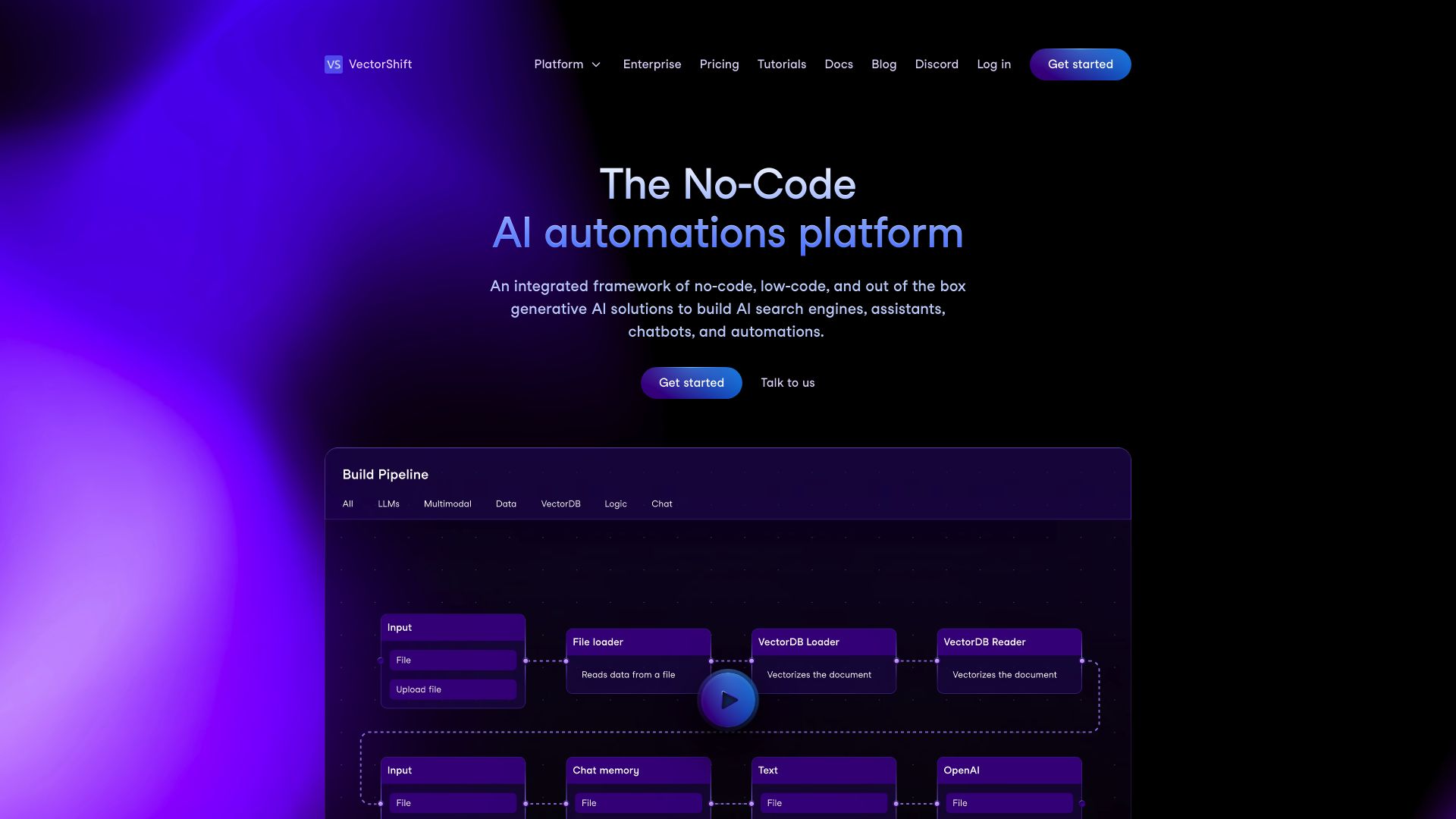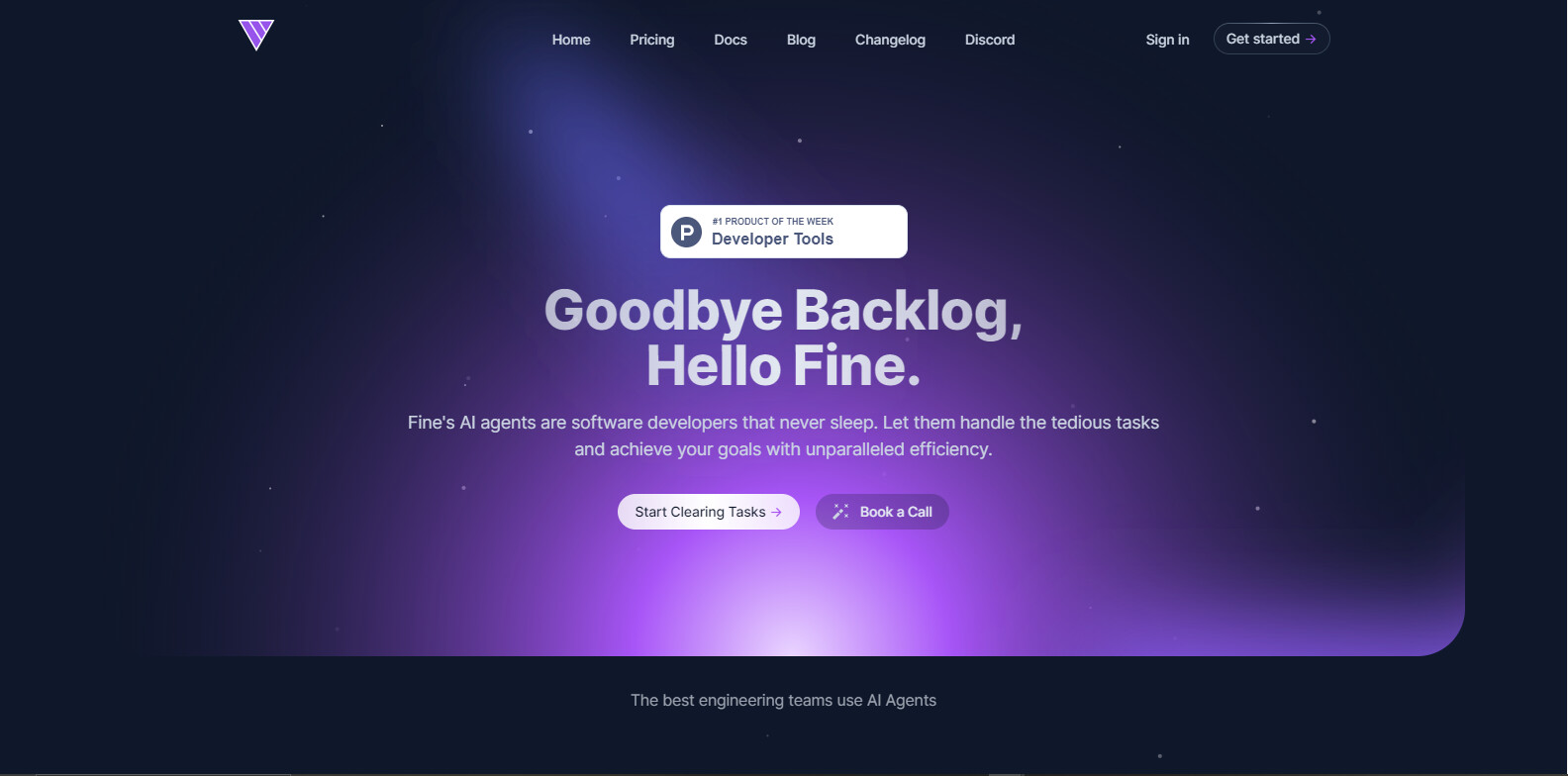VectorShift vs. Fine AI: Comparing AI Agent Builders
AI agent builders have revolutionized software development, empowering teams to create intelligent solutions with unprecedented ease. This comparison dives into VectorShift vs. Fine AI, two platforms at the forefront of AI-driven development. VectorShift offers a versatile approach with no-code and code SDK interfaces, while Fine AI specializes in automating software development tasks. We’ll explore their unique features, integration capabilities, and security measures, helping you determine which platform best suits your AI development needs. Whether you’re a seasoned developer or a business leader seeking to harness AI’s potential, this analysis provides crucial insights for making an informed decision in today’s competitive AI landscape.
VectorShift Overview
VectorShift empowers users to design, prototype, and deploy AI workflows through a versatile platform. The software combines no-code and code SDK interfaces, catering to both technical experts and novice users. This dual approach democratizes AI development, allowing a wide range of professionals to harness generative AI for various applications.


VectorShift’s platform excels in creating diverse AI solutions, from chatbots and search functionalities to complex automations and content generation tools. The software’s pipeline dashboard serves as the core feature, enabling users to build AI workflows from scratch or leverage pre-built templates. This streamlined approach significantly reduces the time and expertise required to deploy sophisticated AI agents.
VectorShift’s platform excels in creating diverse AI solutions, from chatbots and search functionalities to complex automations and content generation tools.
The platform’s integration capabilities stand out, offering seamless connections with popular services like Google Drive, Slack, and Airtable. This extensive integration network allows users to centralize data management and maintain live synchronization across multiple applications. VectorShift also supports advanced content creation, enabling users to generate marketing copy, personalized emails, and even graphics at scale, all adhering to predefined formats and styles.
While VectorShift offers robust features, users should consider potential limitations. The platform’s learning curve may be steeper for those without prior experience in AI workflow design. Additionally, while VectorShift provides a range of deployment options, including chatbots and API endpoints, some users might find the customization options for these deployments less extensive compared to more specialized tools.
Fine AI Overview
Fine AI specializes in creating customized AI agents for automating software development tasks. The platform empowers developers to build agents tailored for backend, frontend, and testing purposes. These agents interpret specifications and implement coherent changes across codebases, streamlining the development process.


Fine AI’s key features include collaborative agent sharing, interactive previews for visual code testing, and a focus on human-AI collaboration. The platform aims to boost developer productivity by eliminating repetitive tasks, allowing engineers to concentrate on complex problem-solving. This approach aligns with Fine AI’s vision of reinventing the developer workflow and restoring the joy of building software.
Fine AI’s key features include collaborative agent sharing, interactive previews for visual code testing, and a focus on human-AI collaboration.
Currently in public beta, Fine AI offers a desktop application for configuring workflows and agents, a library of ready-made agents for common tasks, and the ability to run agents locally on repositories. The platform also provides notebooks for authoring technical specifications, facilitating a seamless integration of AI into existing development processes.
Fine AI’s emphasis on tailored agents aligned to specific technology stacks sets it apart from general-purpose AI assistants. By focusing on transforming the developer’s inner loop through intelligent automation, Fine AI positions itself as a valuable tool for teams looking to enhance their software development capabilities and efficiency.
Feature Comparison
VectorShift and Fine AI both offer AI agent building capabilities, but with notable differences in their core components and security features. VectorShift provides a versatile platform for creating AI workflows through both no-code and code SDK interfaces. It excels in offering a visual builder and pipeline dashboard that simplifies the creation of diverse AI solutions like chatbots, search functionalities, and automations. VectorShift’s integration capabilities stand out, allowing seamless connections with popular services such as Google Drive and Slack.
In contrast, Fine AI focuses specifically on automating software development tasks. It specializes in creating customized AI agents for backend, frontend, and testing purposes. Fine AI’s emphasis on tailored agents aligned to specific technology stacks sets it apart from general-purpose AI assistants. However, it lacks some of the broader integration options and deployment flexibility that VectorShift offers.
Regarding security features, VectorShift demonstrates strengths in data encryption and OAuth support, crucial for enterprise-level deployments. Fine AI’s documentation does not explicitly mention these security features, which could be a significant gap for users prioritizing data protection and secure integrations. This difference highlights VectorShift’s advantage in addressing enterprise security concerns.
Feature Comparison Table
| VectorShift | Fine AI | SmythOS | |
|---|---|---|---|
| CORE FEATURES | |||
| Hosted Agents (Dev, Production) | ❌ | ❌ | ✅ |
| Environments (Dev, Production) | ❌ | ❌ | ✅ |
| Visual Builder | ✅ | ❌ | ✅ |
| No-Code Options | ✅ | ❌ | ✅ |
| Autonomous Agents | ❌ | ✅ | ✅ |
| Explainability & Transparency | ❌ | ❌ | ✅ |
| Debug Tools | ❌ | ❌ | ✅ |
| Multimodal | ✅ | ❌ | ✅ |
| Multi-Agent Collaboration | ❌ | ❌ | ✅ |
| Audit Logs for Analytics | ❌ | ❌ | ✅ |
| SECURITY | |||
| Constrained Alignment | ❌ | ❌ | ✅ |
| Data Encryption | ❌ | ❌ | ✅ |
| OAuth | ✅ | ❌ | ✅ |
| IP Control | ❌ | ❌ | ✅ |
| COMPONENTS | |||
| Foundation AIs | ✅ | ❌ | ✅ |
| Huggingface AIs | ❌ | ❌ | ✅ |
| Zapier APIs | ❌ | ❌ | ✅ |
| All other APIs, RPA | ✅ | ❌ | ✅ |
| Classifiers | ❌ | ❌ | ✅ |
| Logic | ✅ | ❌ | ✅ |
| Data Lakes | ❌ | ❌ | ✅ |
| DEPLOYMENT OPTIONS (EMBODIMENTS) | |||
| Deploy as API | ✅ | ❌ | ✅ |
| Deploy as Webhook | ✅ | ❌ | ✅ |
| Staging Domains | ❌ | ❌ | ✅ |
| Production Domains | ❌ | ❌ | ✅ |
| API Authentication (OAuth + Key) | ✅ | ❌ | ✅ |
| Deploy as Site Chat | ✅ | ❌ | ✅ |
| Deploy as Scheduled Agent | ✅ | ❌ | ✅ |
| Deploy as GPT | ❌ | ❌ | ✅ |
| Scalability | ✅ | ❌ | ✅ |
| DATA LAKE SUPPORT | |||
| Hosted Vector Database | ✅ | ❌ | ✅ |
| Sitemap Crawler | ❌ | ❌ | ✅ |
| YouTube Transcript Crawler | ✅ | ❌ | ✅ |
| URL Crawler | ✅ | ❌ | ✅ |
| PDF Support | ✅ | ❌ | ✅ |
| Word File Support | ✅ | ❌ | ✅ |
| TXT File Support | ✅ | ❌ | ✅ |
Best Alternative to VectorShift and Fine AI
SmythOS stands out as the superior alternative to VectorShift and Fine AI, offering a comprehensive platform for creating and deploying AI agents. We’ve designed SmythOS to be more versatile, user-friendly, and feature-rich than its competitors, making it the ideal choice for businesses and developers seeking powerful AI automation solutions.
Our platform excels in ease of use, boasting an intuitive drag-and-drop interface that simplifies the creation of complex AI workflows. Unlike VectorShift’s limited no-code options and Fine AI’s code-centric approach, SmythOS empowers users of all technical backgrounds to build sophisticated AI agents without extensive programming knowledge.
SmythOS offers a more extensive feature set compared to both VectorShift and Fine AI… Our platform supports multimodal interactions, enables multi-agent collaboration, and offers advanced debugging tools…
SmythOS offers a more extensive feature set compared to both VectorShift and Fine AI. While VectorShift focuses on workflow automation and Fine AI specializes in software development tasks, SmythOS provides a broader range of capabilities. Our platform supports multimodal interactions, enables multi-agent collaboration, and offers advanced debugging tools, features that are notably absent in both VectorShift and Fine AI.
One of the most significant advantages of SmythOS is its unlimited use cases. Unlike Fine AI’s narrow focus on software development or VectorShift’s emphasis on workflow automation, our platform can be applied across various industries and applications. From customer service chatbots to complex data analysis tools, SmythOS adapts to diverse business needs, making it a more versatile and valuable investment for organizations of all sizes.
In terms of deployment options, SmythOS outperforms both VectorShift and Fine AI. We offer a wide array of deployment choices, including API endpoints, webhooks, scheduled agents, and even integration with popular platforms like GPT. This flexibility ensures that AI agents built with SmythOS can be seamlessly integrated into existing systems and workflows, providing a level of adaptability that VectorShift and Fine AI simply can’t match.
Conclusion
VectorShift and Fine AI offer unique approaches to AI-driven development, each with its own strengths. VectorShift’s versatile platform empowers users to create diverse AI solutions through no-code and code interfaces, making it accessible to both technical experts and novices. Its extensive integration capabilities and deployment flexibility stand out, allowing seamless connections with popular services and various deployment options.
Fine AI, focusing specifically on software development tasks, provides specialized agents for backend, frontend, and testing purposes. Its emphasis on tailored agents aligned to specific technology stacks sets it apart, potentially offering deeper value for development teams looking to automate coding tasks.
However, SmythOS emerges as the superior choice, combining the strengths of both platforms while addressing their limitations. Our platform offers unparalleled versatility, supporting over 300,000 integrations and allowing deployment across multiple environments. SmythOS’s visual builder and no-code editor make AI development accessible, while advanced features like autonomous agents, multi-agent collaboration, and problem-solving capabilities push the boundaries of what’s possible with AI.
We invite you to experience the power of SmythOS firsthand. Create a free account today and join the AI revolution. With our risk-free trial offering unlimited agents and a 30-day money-back guarantee, you can explore how SmythOS can transform your workflow and drive innovation in your organization. Discover our diverse range of AI-powered agent templates to jumpstart your journey into the future of AI-driven productivity.
Last updated:
Disclaimer: The information presented in this article is for general informational purposes only and is provided as is. While we strive to keep the content up-to-date and accurate, we make no representations or warranties of any kind, express or implied, about the completeness, accuracy, reliability, suitability, or availability of the information contained in this article.
Any reliance you place on such information is strictly at your own risk. We reserve the right to make additions, deletions, or modifications to the contents of this article at any time without prior notice.
In no event will we be liable for any loss or damage including without limitation, indirect or consequential loss or damage, or any loss or damage whatsoever arising from loss of data, profits, or any other loss not specified herein arising out of, or in connection with, the use of this article.
Despite our best efforts, this article may contain oversights, errors, or omissions. If you notice any inaccuracies or have concerns about the content, please report them through our content feedback form. Your input helps us maintain the quality and reliability of our information.
